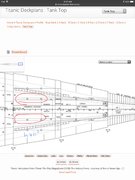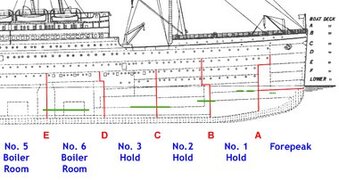Robby House
Member
Okay, I want make sure I'm picturing this correctly. So WTB B makes up the forward most wall of the Fireman's Tunnel/Staircase...(at least from the Tanktop level to G-Deck before the bulkhead's aft jogging job). When Titanic impacts the ice, the force of impact exerted against WTB B cause it thrust "inboard" in the opposite direction towards the port side. The rivets that connected the tunnel/stairs to this bulkhead where compromised enough to allow ingress once flooding in Hold 2 reached the level of damage on the opposite side of the wall. I've included a crude hand doodle to describe my interpretation of architect William Garzke's theory. Just making sure I follow correctly.
Robby
PS- Exactly what and where is the access trunk? I'm not sure I follow this description. Are the talking about the spiral staircase leading down to the TankTop level?

formed the forward-most wall of the Fireman's passageway (at least for the first few decks before jogging aft) or more specifically the spiral staircase leading to the Fireman's passageway. When Titanic makes contact with the iceberg, the impact against WTB B sort of jars or juts it in the direction of the portside (kind of at a 90 degree angle juxtapostion to the fireman's passageway. Along the steam of where the Tunnel is physically attached to WTB B the force of the impact is sufficient enough to The impact is sufficient enough to have effected a seam opening somewhere along where the fireman's tunnel is physically attached against WTB B.
Robby
PS- Exactly what and where is the access trunk? I'm not sure I follow this description. Are the talking about the spiral staircase leading down to the TankTop level?
The above from naval architect William Garzke, posted earlier by Ioannis, to me appears to be the only rational explanation for what Henderickson saw at the bottom of the staircase. You can see the starboard side of this access trunk in the diagram I posted above next to the starboard side spiral staircase. (The view is looking aft so the starboard side is on the left.) This point was immediately behind WTD B in Hold 2. The only double-bottom protection in that space is the tanks shown.
formed the forward-most wall of the Fireman's passageway (at least for the first few decks before jogging aft) or more specifically the spiral staircase leading to the Fireman's passageway. When Titanic makes contact with the iceberg, the impact against WTB B sort of jars or juts it in the direction of the portside (kind of at a 90 degree angle juxtapostion to the fireman's passageway. Along the steam of where the Tunnel is physically attached to WTB B the force of the impact is sufficient enough to The impact is sufficient enough to have effected a seam opening somewhere along where the fireman's tunnel is physically attached against WTB B.
The above from naval architect William Garzke, posted earlier by Ioannis, to me appears to be the only rational explanation for what Henderickson saw at the bottom of the staircase. You can see the starboard side of this access trunk in the diagram I posted above next to the starboard side spiral staircase. (The view is looking aft so the starboard side is on the left.) This point was immediately behind WTD B in Hold 2. The only double-bottom protection in that space is the tanks shown.


